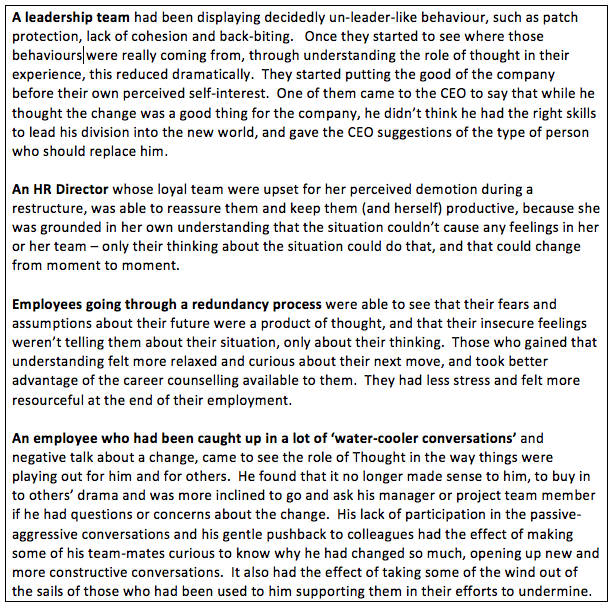In part 1 we covered what resistance to change is, what it’s really telling us, and where the most leverage is in terms of intervention.
In part 2 we will look at how an intervention based on the understanding of how the mind works can make a difference – we’ll explore the implications of really understanding what I’m pointing to here.
The practical implications of understanding

Do you remember learning to ride a bike? For a while, it seemed like the hardest thing in the world, and you felt like you had to ‘do’ it.
Then at some point, you got an embodied understanding of what it takes to ride a bike – everything you needed to know about gravity, balance and motion came together at once and you ‘got it’. You were no longer ‘trying’ to ride a bike, you were just riding it.
Understanding and working in alignment with the laws of nature made the job much easier than when you were trying to guess what you had to do, or figure it out intellectually.
That’s one practical implication of understanding how things operate. Your life is played out within the laws of the universe, so it really helps to understand how they work.
That’s why Newton’s articulation of the law of gravity was so helpful – it answered questions and made sense of things that had been tried and failed. If you want to invent a flying machine, the laws of physics will tell you why strapping wings to your arms and flapping won’t get you far.
The same goes for understanding how the mind works.
When we’re taking a ‘best guess’ at what will help our people navigate change more gracefully, we’re metaphorically riding a bike for the first time (every time). We’re going in with theories and models, which all admit to not being universally applicable. Someone is always the exception.
In the context of organisational change, there will always be someone who doesn’t care about your reasons why the change is a good idea, and will stick to their own reasoning because they don’t see what you see.
That’s normal, and it’s to be expected – we all live in our own thought-created world, and we can’t expect someone else’s to look and feel the same as ours. But if we’re in the same misunderstanding as them – i.e.: thinking that the change could be the cause of their upset/fear/obstinacy – we will still refer back to the theories and models to help us ‘turn them around’. We’re starting from a false premise, and therefore (as in our bike analogy) we’re going to have the wobbles and potentially the odd crash.
When we help a person to see how their experience of change is really being created, the ‘training wheels’ of theories or models are surplus to requirements; people understand and work with the system rather than struggling in a misunderstanding.
That’s not to say you won’t get people disagreeing with the premise of the change, or expressing opinions, or even becoming upset. Just because you’ve pointed someone to the truth about where their experience is coming from, doesn’t mean they’ll see it in every moment, and just because someone sees the role of Thought in their experience, doesn’t mean that they’ll automatically agree that the change you’ve proposed or are helping to implement is a good thing.
And of course, they may just have a point – that will be up to you to decide together, in a conversation that will be far more constructive than it would have been if you were both still stuck in the misunderstanding of where your feelings come from.
Here are a couple of examples to illustrate:

These examples show the practical implications of starting to understand the role of Thought in our experience of change.
Imagine a whole team or organization starting naturally to act in ways that will progress the change rather than hold it back.
Imagine being able to truly help people who are feeling distressed and helpless in a change that they haven’t asked for and don’t want.
These are not pipe dreams. This is what’s possible when people gain an understanding of how their felt experience of life is created through their thinking.
So, if a change consultant offers you the latest models or techniques to try and ‘deal with’ resistance in your organization, you might want to remember that fancier training wheels aren’t the answer to ‘how do I ride a bike’.
Instead, I’d recommend finding someone who is grounded in this understanding of the mind, and experiencing for yourself the transformation that comes with it. It will be a no-brainer for you to then begin to spread it through your organisation, and watch your change initiatives, and your people, really thrive.
This article is brought to you exclusively by The Business Transformation Network.


